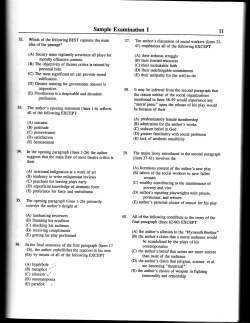
Optical Properties of Solids, Second Edition Mark Fox
Optical Properties of Solids, Second Edition Mark Fox Oxford University Press, 2010 Reprinted with corrections, 2011 Errata Please send an email to the author if you discover any new errors that are not listed here. Updated: January 20, 2015 2011 reprint and later Page 14 Line 15: most people would describe the colour of copper as “reddish” rather than “pinkish”. Page 20 Three lines after eqn 1.30: delete “envelope”. The term “envelope function” is normally applied to the slowly-varying part of the wave function, i.e. the exp(ik · r) part. It is the envelope function that is modified in low-dimensional structures, as shown, for example, in eqns 6.32 and 6.33. Page 51 Second paragraph, line 6: change “r-ray” to “e-ray”. Page 131 Line 34: change band gap frequency Eg /e to Eg /h. Page 139 Exercise 5.17: change GaAsx P1−x to GaAs1−x Px twice. Page 144 Section 6.2, line 2: change “contains” to “contain”. Page 304 Above eqn 11.35: change “eqn 1.4” to “eqn 1.3”. page 324 Section 11.4.7, second paragraph, line 4, should read “from the valence band to the conduction band”. Page 359 Line 2: change “an envelope function” to “a function”. 2010 print run The errors listed for the 2011 print run are also present in the 2010 print run. Page 3 Two lines after eqn 1.2: Insert dispersion after “This effect is called . . . ” Page 7 Change “eqns 1.25 and 1.26” in the line above eqn 1.27 to “eqns 1.23 and 1.24”. Page 35 Four lines after eqn 2.21: replace “an oscillator” with “a set of oscillators”. Page 36 Caption to Fig. 2.4: delete “,0” after “st = 12.1”. 1 Page 37 Sidenote: The comparison between the calculated absorption coefficient and the measured absorption for the sodium transition is misleading. The atom density (1011 cm−3 ) and line width (100 MHz) were taken from the paper by Slusher et al. in Phys. Rev. A 31, 3512 (1985). However, the line is Doppler-broadened in the experiment, and so the Lorentzian model is not applicable. The actual oscillator strength for the transition is 0.65, and the absorption coefficient measured in the experiment was 500 m−1 . Page 71 For consistency with the naming of the other bands, it would be better to have “electron” instead of “conduction” two lines above eqn 3.17, and to change Ec to Ee in eqn 3.17. Page 85 The caption to Table 3.2 has not printed properly. The caption should read: “Experimental considerations for reflection and transmission measurements in different spectral regions. Note that the transition points from the infrared to near infrared and from the ultraviolet to vacuum ultraviolet spectral regions are not uniquely defined, and the values listed here are only approximate.” Page 88 Third bullet point, penultimate sentence: this should read “. . . such that the band gap of the top contact is larger than the energy of the photons to be detected.” Page 91 Point (1): Change IOC to ISC . Page 108 There are inconsistencies in the exciton and band gap parameters of NaCl and LiF. In Section 4.5.2, paragraph 3, line 4, the binding energy of LiF should be 0.9 eV. In Table 4.3, Eg = 8.7 eV and Eb = 0.8 eV for NaCl, and Eb = 0.9 eV for LiF. Page 189 Figure 7.3: The x axis title, i.e. “Wave vector k”, is missing. Page 237 Caption to Fig. 8.22: the attribution of the slight drop in transmission at short wavelengths to “hydrocarbon contamination” followed the explanation given in the paper by Nair et al. More recent work by the same research group and also other groups has clarified that graphene has a broad absorption peak at 4.6 eV, which affects the transmission at the short wavelength end of the visible spectral region. This peak is attributed to a van Hove singularity in the density of states of graphene, with its position shifted by excitonic effects. See Kravets et al., Phys. Rev. B 81, 155413 (2010) and Mak et al., Phys. Rev. Lett. 106, 046401 (2011). Page 251 Last paragraph line 2: insert “approximately” in front of “proportional to”. Page 252 First line: insert “approximate” in front of “inverse-square”. First line after eqn 9.5: change “correct” to “approximate”. Insert sidenote: “Detailed analysis reveals that the energy of the F-band absorption actually scales as a−1.84 rather than a−2 . This empirical formula is called the Mollwo–Ivey relationship.” Page 335 Equation A.37 should read: µ0 µ r ω Z= = k 2 r µ 0 µr 1 = . 0 r c0 n Page 338 Equation A.53 should read: E rx n ˜−1 . =− i n ˜+1 Ex End cover The value of c is exactly 299 792 458 m/s. 3
© Copyright 2025















